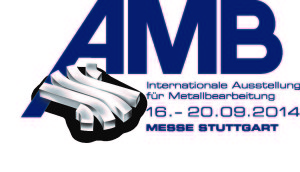 The efficient machining of composites and composite materials is currently one of the key topics of manufacturing technology. True to its motto “Key to markets”, Messe Stuttgart is also making this a major topic at the upcoming AMB, the international exhibition for metalworking, which takes place from 16 to 20 September 2014 in Stuttgart. Under the heading “Competence in composites”, exhibitors display their special skills in this area. Trade fair visitors can find these exhibitors very quickly thanks to a corre-sponding logo at the trade fair stands and special information in the trade fair guide. Visitors can also obtain information within the framework of the event series of business breakfasts. “Introduction to composites and precision tools” by the Stuttgart Region Economic Development Cooperation, which also dedicates itself to the topic with several presentations.
The efficient machining of composites and composite materials is currently one of the key topics of manufacturing technology. True to its motto “Key to markets”, Messe Stuttgart is also making this a major topic at the upcoming AMB, the international exhibition for metalworking, which takes place from 16 to 20 September 2014 in Stuttgart. Under the heading “Competence in composites”, exhibitors display their special skills in this area. Trade fair visitors can find these exhibitors very quickly thanks to a corre-sponding logo at the trade fair stands and special information in the trade fair guide. Visitors can also obtain information within the framework of the event series of business breakfasts. “Introduction to composites and precision tools” by the Stuttgart Region Economic Development Cooperation, which also dedicates itself to the topic with several presentations.
“The increase of composites in production and especially series production is creating a demand for technologies, machines and tools”, is how Dr.-Ing. Marco Schneider, Department Director, Lightweight Construction Technologies, at the Fraunhofer Institute for Production Technology and Automation (IPA) in Stuttgart, describes the general direction. Despite near net shape manufacturing, many components made from composites usually require machining. “The transfer from metalworking to machining com-posites, CFRP (carbon fibre reinforced plastics) or sandwiches is only possible with spe-cial measures. This starts with the machine tool, the machining technology, the cooling and lubrication concept, and extends to the tools, the extraction through to the quality control.” The broad range of composites also lays down very individual requirements in relation to tools, machines and process parameters. In his presentation within the framework of the business breakfast, on 18 September at 9.30 in the “Regio Lounge” at the East entrance, he will mention the requirements of “Precision tools for machining composites”.
Dr. Schneider sees huge possibilities with lightweight materials, which extend beyond the well-known fields of application in the aviation and automotive sectors to many other areas. However, two obstacles are still preventing any breakthrough; firstly, the new way of thinking required in composites, or fibre-based materials, and secondly, the alternative manufacturing and machining methods required. “The necessary knowledge and production equipment must be established in the company, which requires corre-sponding investment.” However, he warns against the “wrong approach” of a pure mate-rial substitution in line with the motto: “We use carbon sometimes instead of steel sheet.” If used correctly, however, composites “could have a nucleus effect, in order to think in terms of these new materials and the possibilities, apply the new manufacturing methods for other products and thus drive product and production innovation.”
Dr. Simon Küppers, Deputy Department Director, Fibre Composite Technology, at the Institute of Textile Technology and Process Engineering” (ITV ) Denkendorf, who will also deliver a presentation in the “Regio Lounge” on 19 September at 9.30, sees it from a completely different angle. He examines “Fibre composite technology, joining tech-niques and organic sheeting” from a textile point of view. In order to further reduce the weight, smart functions cannot only be integrated into the components, but directly into the textile and even into the fibre. The resin systems could also assume additional functions. “Weight reduction can also be achieved by system monitoring, i.e. the moni-toring of components, because then the safety factors can be reduced with the design”, states Dr. Küppers. Another approach he mentions is “tailored fibre placement”. Bionic designs and fibre orientations imitate nature and make them useful for technologies. Weaving and braiding technologies, as well as preform technologies, are other ways to make components lighter. “There is thus a strong focus on textile engineering, as it is already familiar with a complete range of efficient methods for meeting requirements from fibre composite technology”, states Dr. Küppers with confidence.



